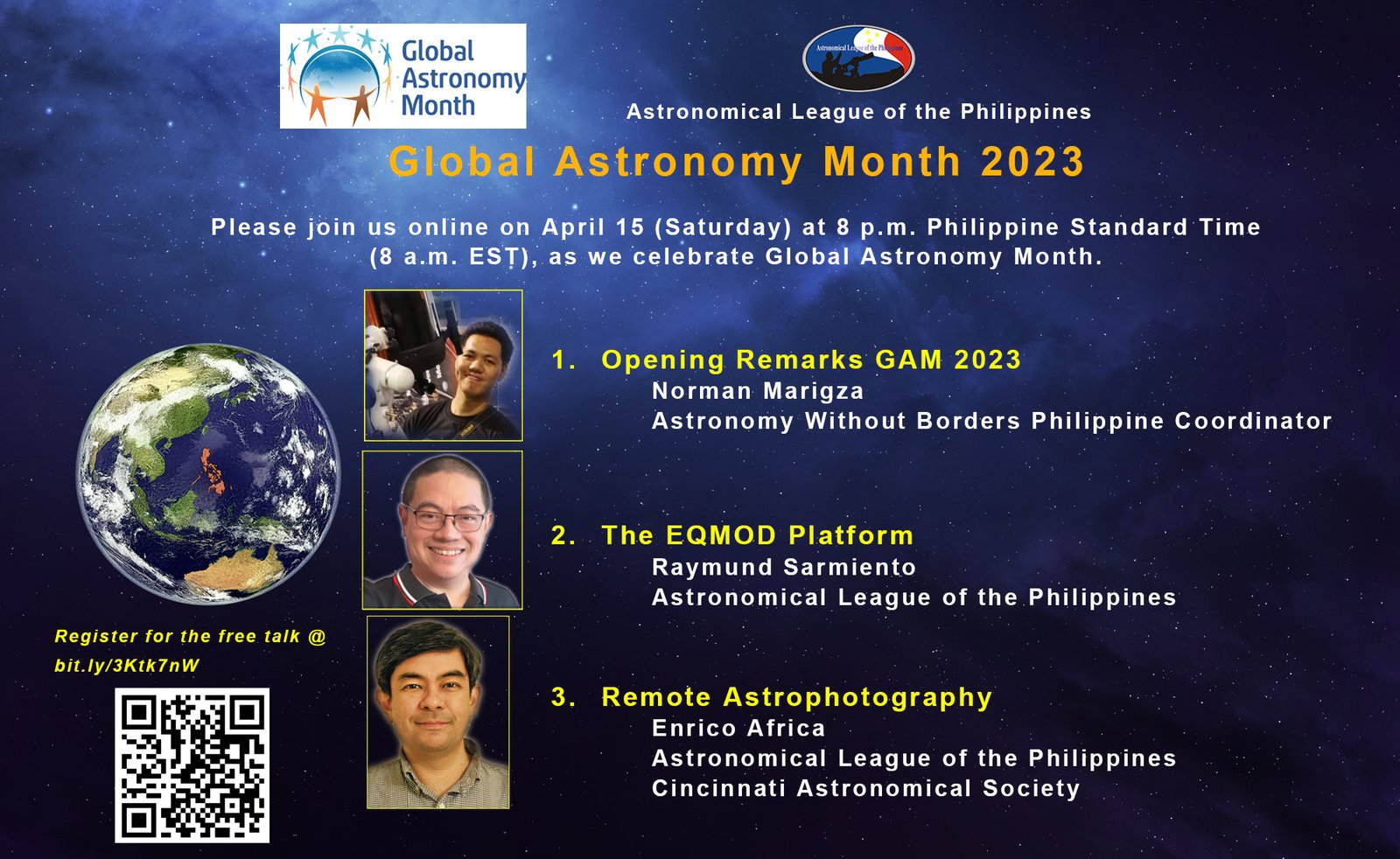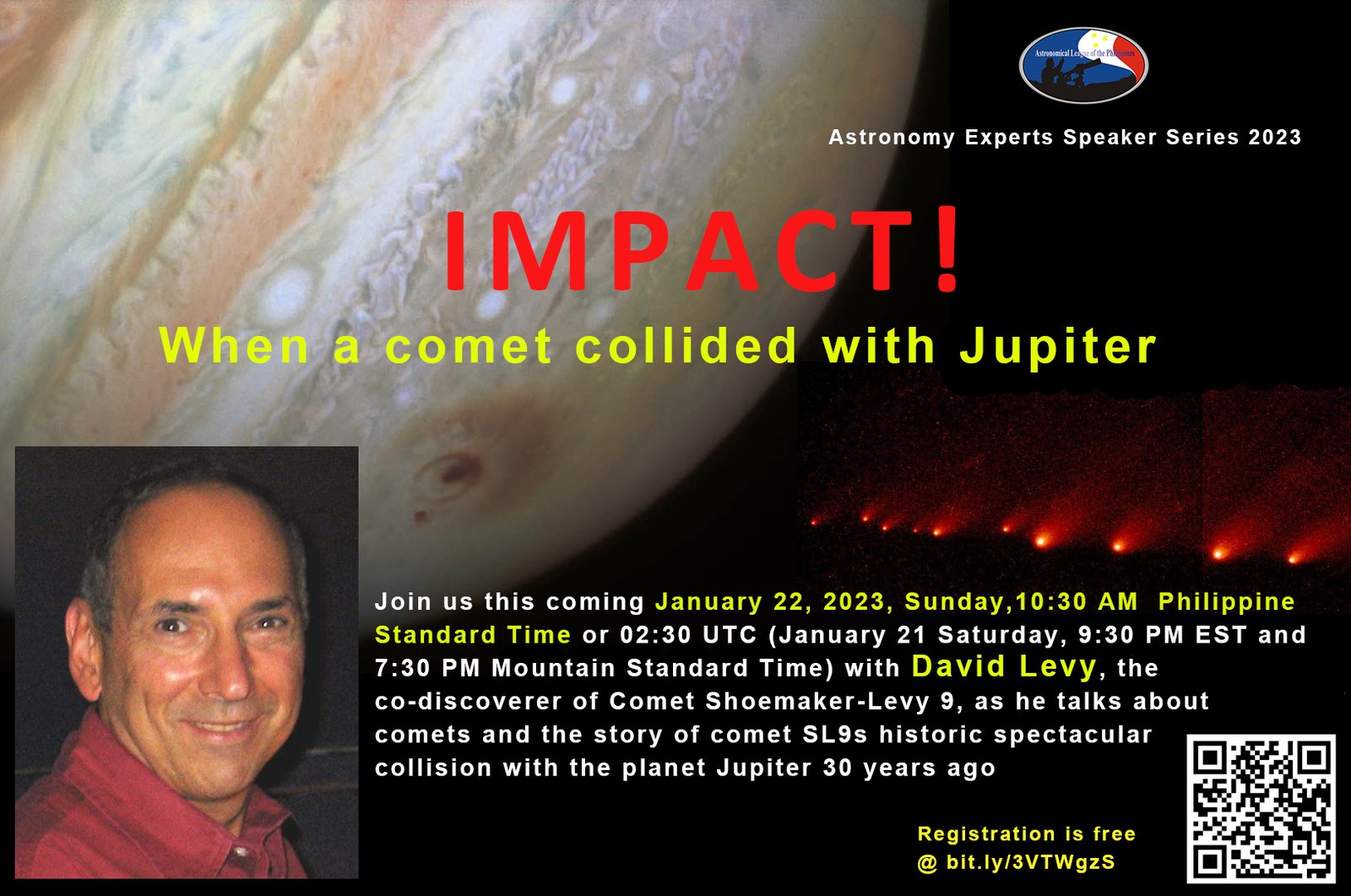Webinars
2023 Father Victor L. Badillo Astronomy Service Award

![]()
![]()
ALPer Raymund Sarmiento is this year’s Father Victor L. Badillo Astronomy Service Awardee for 2023 for his “For his innovative development of EQMOD, an open source telescope mount control software, which greatly aided astronomers worldwide.”
Raymund is the Senior Vice President and Chief Technical Officer of GMA New Media, the technology arm of GMA Network.
Serving as CTO of GMA New Media for the past 20 years, he is the co-inventor of some of the R&D projects for the organization, with patents obtained and applied locally and abroad.
He has extensive experience in AI and robotics, recently creating from scratch a Rubiks Cube Solver Robot.
An amateur astronomer as well as member of ALP since 2004, he also developed a Telescope Observatory / Automation algorithm called EQMOD, which he launched as an open source project in 2006. It remains active to this day.
April 15, 2023 ALP Global Astronomy Month Astro Webinar Talk
Please join us online this coming April 15, 2023, at 8:00 p.m. Philippine Standard Time (8:00 a.m. EST), as we celebrate Global Astronomy Month.
There will be two online talks to be given by our Astronomical League of the Philippines members. The first talk will be on “The EQMOD Platform” by Mr. Raymund Sarmiento. EQMOD is an open-source software project that was initially developed by a team of amateur astronomers led by Mr. Sarmiento. The project was started in the early 2000s as a way to provide computer control of equatorial telescope mounts, which can be used for astrophotography and other observational purposes. The development of EQMOD was made possible through the collaborative efforts of a community of amateur astronomers who contributed their time, skills, and resources to create an open-source software platform that is available to everyone. Today, EQMOD continues to be developed and maintained by a community of volunteers who support the software and its users.
The second talk will be on “Remote Astrophotography: The dream, the challenges” by Mr. Enrico Africa, who is also a member of the Cincinnati Astronomical Society. Mr. Africa will discuss the options available for remote astrophotography and the solutions he had discovered based on his own experience. He will specifically mention what one would need in doing remote astronomical photography in terms of hardware and software requirements as well as what are currently available. Enrico “Eric” Africa is a passionate amateur astronomer and astrophotographer and had been interested in astronomy for most of his life The apparition of Comet Hyakutake (C/1996 B2) in 1996 triggered his interest in observational astronomy. Comet Hale-Bopp (C/1995 O1) in 1997 got him into astrophotography, first using film, and then digital imaging starting in 2001. Many of his images have been featured in Sky & Telescope, Astronomy Magazine and Astronomy Now magazines. He has been using a remote observatory in the dark skies of New Mexico since 2011.
March 12, 2023 ALP Astro Experts Series Webinar 2023 with Heidi Hammel, Ph.D
Please join us this March 12 (Sunday) at 10 A.M. Philippine Standard Time (March 11, Saturday, 9 P.M. EST) for the Astronomy Experts Speaker Series 2023 online talk on:
“The First Year of the James Webb Space Telescope: What We’ve Learned, What Is Still to Come” by Heidi Hammel, Ph.D.
Abstract:
The James Webb Space Telescope (JWST) launched into space on Christmas Day, 2021. During its first year, this innovative observatory has already made revolutionary advances across astronomy with its infrared capability and high sensitivity. In this talk, Dr. Heidi B. Hammel will describe how JWST came to be and what it was designed to do, with personal insights into the long and complicated path to its launch. She will highlight amazing results from JWST’s first year, from discoveries about our nearby neighbors in the Solar System, to the spectacular deep-space images of distant galaxies. Dr. Hammel will also describe JWST’s studies of planets around other stars, explaining how we can study their atmospheres. She will finish with a look ahead not only for JWST, but also for the future of space astrophysics.
February 19, 2023 ALP NAW Opening Talk / Astronomy Experts Speaker Series
Last February 19, Astronomical League of the Philippines had their NAW opening program featuring Astronomy Experts Speaker Series in celebration of National Astronomy Week 2023 with great astronomical Lectures coming from from former Sky and Telescope magazine editors J. Kelly Beatty , Imelda Joson & Edwin Aguirre and ALP observations Chairman Peter Benedict Tubalinal and also a Great Opening Remarks coming from IAU President Dr. Debra Elmegreen.
ALP will also be providing 2 free telescope viewing events on February 19 and 25, 2023 at SM Mall of Asia SMBY as well.
Full video coverage link will be posted in the days to come at Astronomical League of the Philippines Official You Tube Channel
https://youtube.com/@astronomicalleagueofthephi9669
Please do subscribed, like and jot the notification bell to get latest updates on our speaker series.
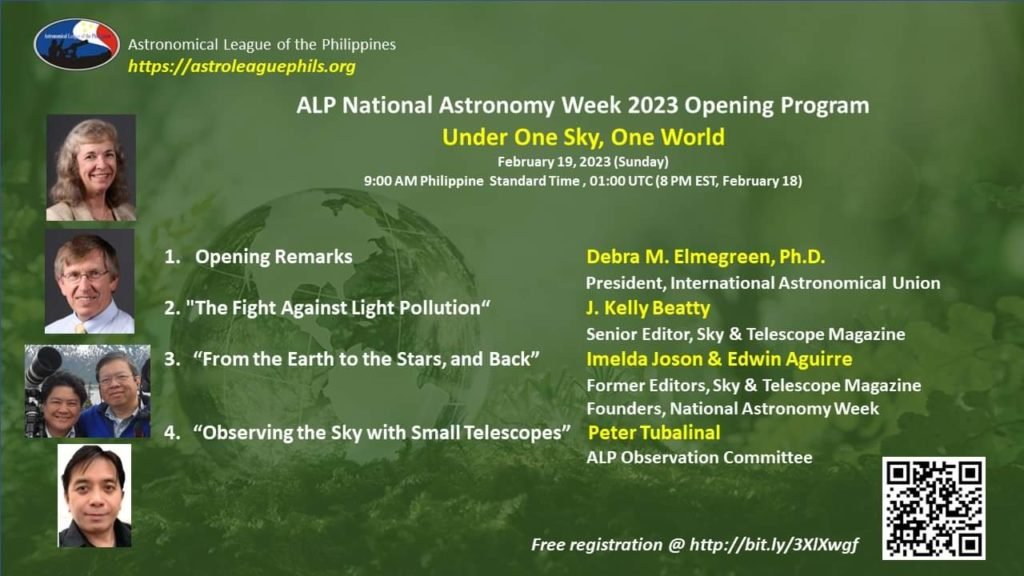

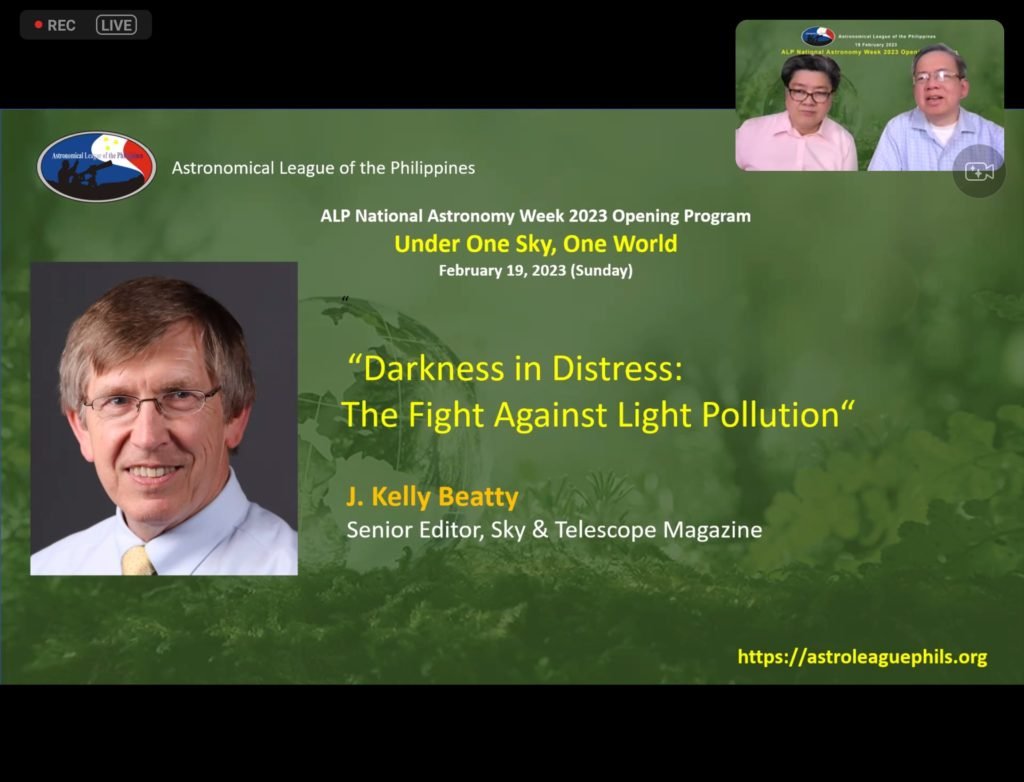
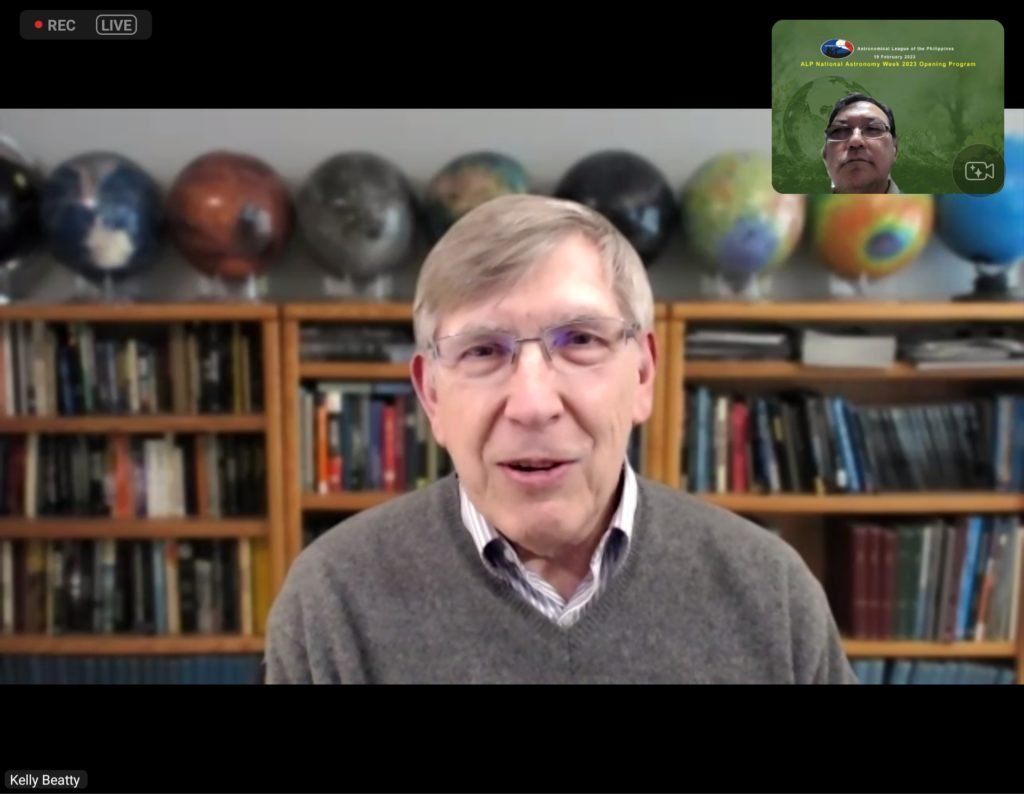
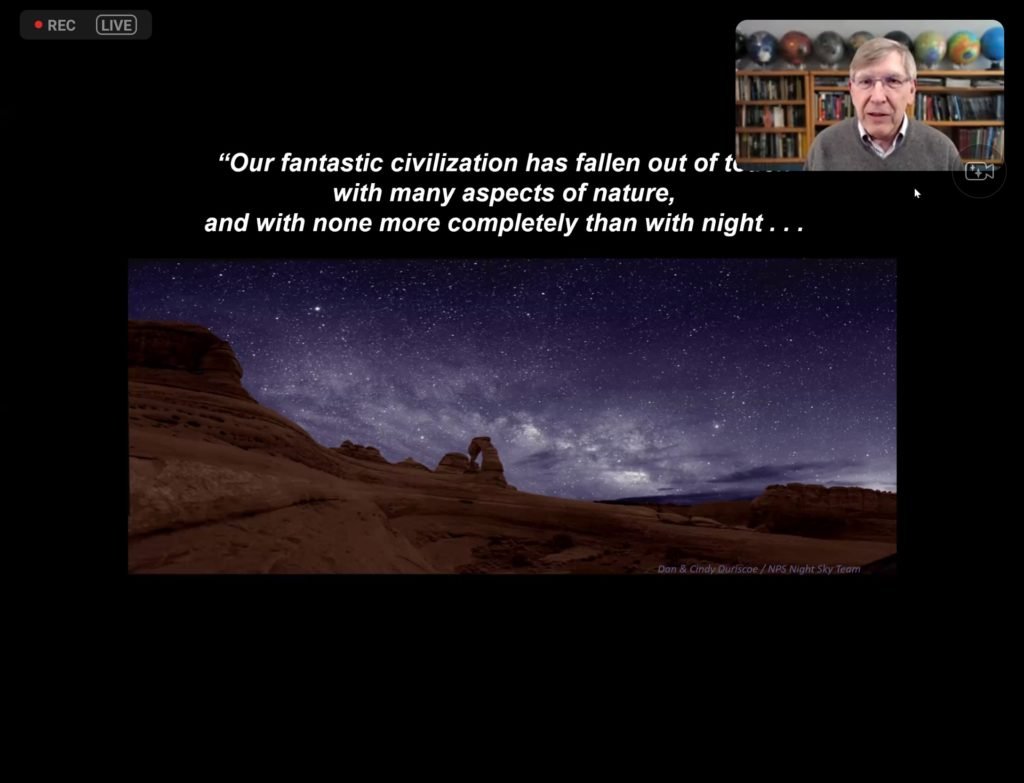
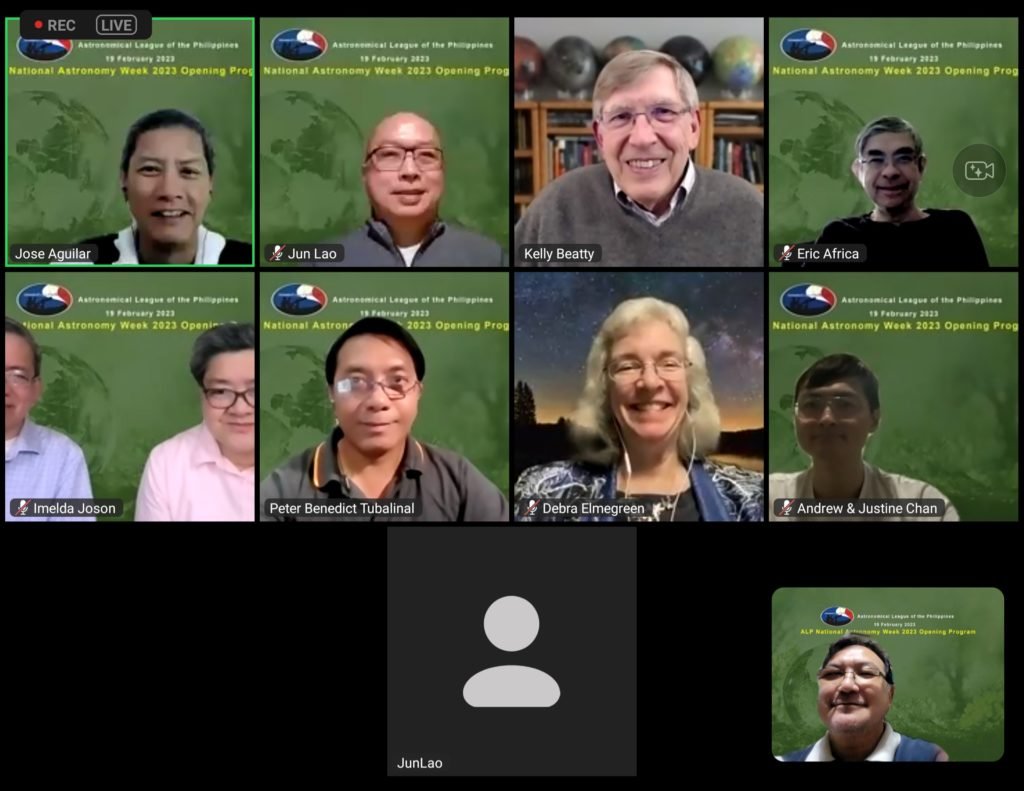

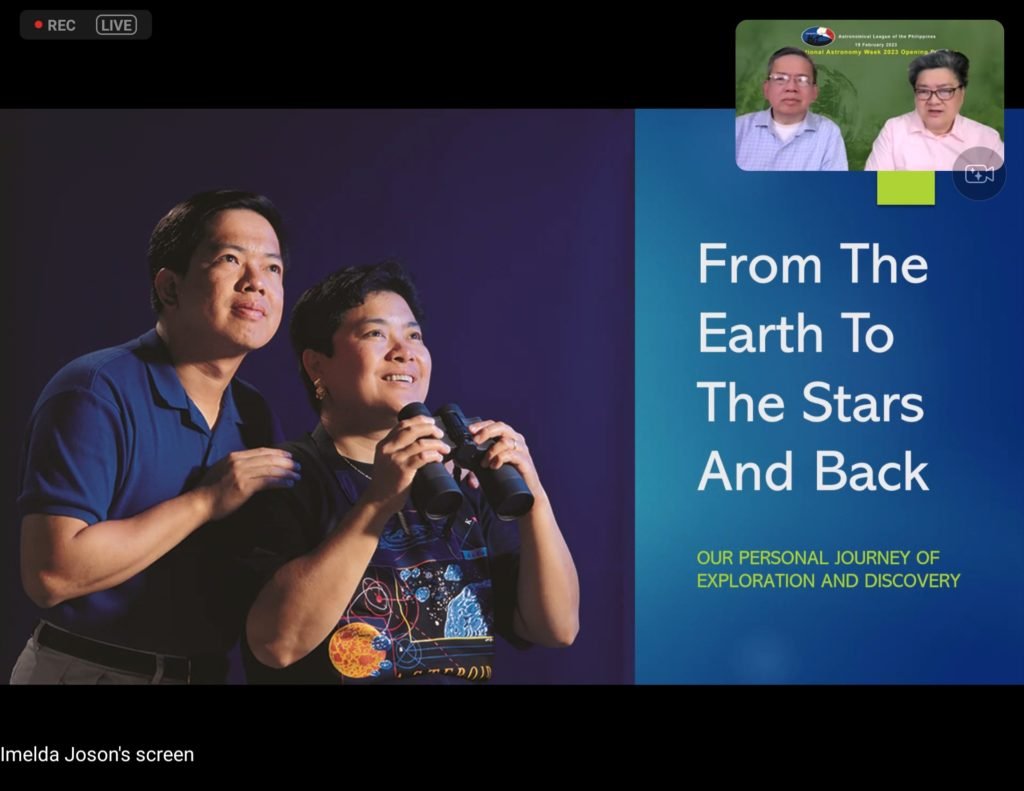

February 19, 2023 NAW Opening Program Talk
Please support and attend our ALP National Astronomy Week 2023 Opening Program (via Zoom) to be held this coming Sunday, Feb 19, 2023, 9:00 AM Philippine Standard Time , 01:00 UTC (8 PM EST, February 18)
We have invited several esteemed speakers for our ALP NAW 2023 theme – “Under One Sky, One World”. We are very fortunate to have with us none other than the current President of the International Astronomical Union IAU), Dr. Debra M. Elmegreen to give the Opening Remarks. The Senior Editor of the very prestigious Sky & Telescope Magazine, J. Kelly Beatty will then talk on “The Fight Against Light Pollution”. This will be followed by Ms. Imelda Joson and Mr. Edwin Aguirre who will speak on “From the Earth to the Stars, and Back: Our Personal Journey”. The last speaker will be Mr. Peter Tubalinal of the Astronomical League of the Philippines who will discuss “Observing the Sky with Small Telescopes” in addition to cellphone astrophotography.
Register now for this free Zoom online program using this link http://bit.ly/3XlXwgf or by scanning the QR code in the poster shown here using your cellphone camera. After registration, check your registered e-mail for the Zoom meeting link. See you!
January 22, 2023 ALP Astro Experts Series Webinar 2023 with David Levy
Impact! When a comet collided with Jupiter
The Astronomical League of the Philippines welcomes the New Year with a fascinating online talk revisiting the first observed impact of a comet with the planet Jupiter.
Join us this coming Sunday, January 22, 2023 at 10:30 AM Philippine Standard Time (02:30 UTC, 9:30 PM EST January 21) with David Levy, the co-discoverer of of Comet Shoemaker-Levy 9, as he talks about comets and the story of comet SL9s historic spectacular collision with the planet Jupiter 30 years ago.
David Howard Levy is a Canadian amateur astronomer and science writer based in Vail, Arizona. To date, he has discovered 23 comets and 61 minor planets, and has written 34 books, mostly about astronomy.
Abstract: 2023 marks the 30th anniversary of the discovery of Comet Shoemaker-Levy 9. The comet was discovered by the team of Gene and Carolyn Shoemaker and David Levy on March 24, 1993, using an 18-inch Schmidt camera at Palomar Observatory near San Diego, California. Fragments of SL-9 crashed into Jupiter during the summer of 1994, producing some of the largest impacts ever observed in our solar system. David will talk about how they discovered the comet and the danger of such objects colliding with Earth in the near future.
December 17, 2022 ALP Astro Experts Series Webinar 2022 with Father Christopher J. Corbally, SJ
What was the Star of Bethlehem?
This was the celestial phenomemon that guided the three Wise Men to the birthplace of the infant Jesus Christ. Was it a miracle? A fable? Or scientific reality? Jesuit professional astronomer Father Chris Corbally will try to shed some light on this gospel mystery from the perspective of modern astronomy as well as from exploring ancient wisdom.
Join us this December 17, 2022 for a free online talk by Fr. Chris Corbally, S.J., “What was the Star of Betehem?”, 8:30 PM Philippine Standard Time (7:30 AM EST, 12:30 UTC).
Fr. Christopher J. Corbally, S.J., is a Jesuit priest and astronomer with the Vatican Observatory Research Group in Tucson, Arizona. He is also an Adjunct Associate Astronomer at the University of Arizona’s Department of Astronomy. Father Corbally principally uses spectroscopy to investigate the evolution of stars, and he is co-author of the comprehensive volume, Stellar Spectral Classification. He was the Project Scientist for the Vatican Advanced Technology Telescope on Mount Graham, Arizona, and served as President of the International Astronomical Union’s Division IV (Stars) from 2009 to 2012. Father Corbally was ordained in the Society of Jesus in 1976 and earned a Ph.D. in astronomy from the University of Toronto in 1983. In 2020, the International Astronomical Union recognized his contributions to astronomy by naming asteroid 119248 Corbally.
November 12, 2022 ALP Astro Expert Series Webinar 2022 with Scott Roberts
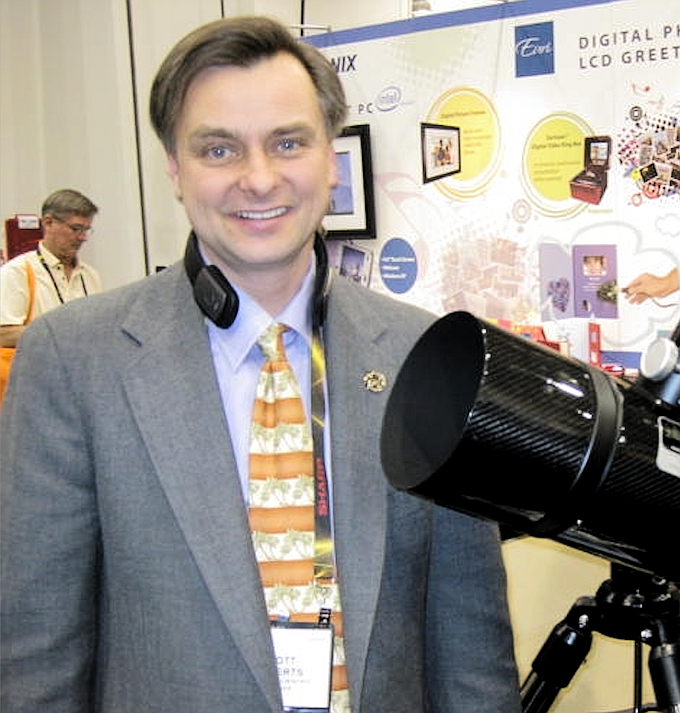
“The Power of Stargazing”
Join us this November 12, 2022 (Saturday), 8:30 PM Philippine Standard Time (6:30 AM CST, 7:30 AM EST, 12:30 UTC) on “The Power of Stargazing” by Scott W. Roberts. This is part of our regular Astronomical League of the Philippines Astronomy Experts Speaker Series for 2022 and registration is free.
Scott Wayne Roberts (born 1959) is a designer and marketer of amateur astronomy equipment. He is well known around the world for his dedication and avid support of educational public outreach in astronomy and space exploration, as well as his tireless popularization of amateur astronomy. He is the founder and President of Explore Scientific, one of the largest manufactures and distributors of telescopes and astronomical equipment in the world. He also founded the Astronomy Outreach network in 2000 and has served on the board of directors of the Astronomical Society of the Pacific, the International Dark-Sky Association, the National Sharing the Sky Foundation, and Astronomers Without Borders. In 2000, the International Astronomical Union officially named asteroid 1993 OA3 as “15779 Scottroberts” in his honor.
Abstract: Scott Robert’s talk on “The Power of Stargazing” is about how commercial telescopes are made, and the transformative and beneficial effect they can have on people as they explore the night sky and begin to understand for themselves their connection with the cosmos.
September 24, 2022 ALP Astro Expert Series Webinar 2022 with Mathew Barlow
The Astronomical League of the Philippines would like to invite you to a very timely and relevant webinar, “Turning the Telescope Back on Earth: The Challenges of Living on a Warming Planet”, on September 24, 2022 (Saturday), 8:30 PM Philippine Standard Time (12:30 UTC, 8:30 AM EDT).
This webinar will be given by Mathew Barlow. He is a Professor of Climate Science at the University of Massachusetts Lowell. His expertise is on large-scale climate variability and climate change. Prof. Matt Barlow is one of the lead authors in the 2021 United Nations Intergovernmental Panel on Climate Change (IPCC) Sixth Assessment Report.
Abstract:
We have all been hearing in the news about global warming and climate change. Prof. Matt Barlow will give us an overview from the perspective of planetary science, starting with an introduction to a planet’s “energy balance,” which represents the movement of heat energy from the Sun and the planet’s core into its atmosphere, as well as the loss of that heat into space. He will compare the energy balance of Earth to other planets and consider the role of different types of atmospheres. That information is then used to take a brief, 4-billion-year tour of how Earth’s climate has evolved from both natural and human-caused changes to its atmosphere. Prof. Barlow will also survey the current and future impacts due to these changes, both globally and for a tropical country and island nation like the Philippines, in terms of heat waves, droughts, heavy rainfall and flooding, super typhoons, and rising sea levels. Finally, he will discuss what we can do about it and lay out a roadmap for action.



